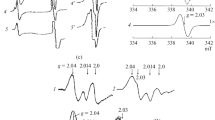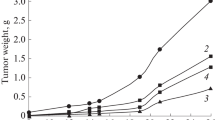Abstract
This work is a part of a directional search for new crystal donors of nitric oxide (NO), which are promising for complex chemotherapy. The relationships between the physico-chemical properties of NO donors, their genotoxic and mutagenic activities, and the dependence on intracellular iron were studied. New crystal NO donors (di-and trinitrosyl iron complexes with synthetic ligands) were examined for the first time and compared with known NO donors containing natural ligands. All but one compound induced expression of the Escherichia coli sfiA gene belonging to the SOS regulon and exerted a mutagenic effect on Salmonella typhimurium TA1535. These effects were fully or significantly inhibited by the iron(II)-chelating agent o-phenanthrolin, depending on the mono-or binuclear structure of the ligands. The rate of donating free NO in solution did not positively correlate with the genotoxic activity of the crystal NO donors. The genetic activity of all NO donors proved to depend on intracellular iron.
Similar content being viewed by others
References
Vanin, A.F., Nitric Oxide in Biology: History, State of Art, and Research Perspectives, Biokhimiya, 1998, vol. 63, no. 7, pp. 867–869.
Hemish, J., Nakaya, N., Mittal, V., et al., Nitric Oxide Activates Diverse Signaling Pathways to Regulate Gene Expression, J. Biol. Chem., 2003, vol. 278, no. 43, pp. 42321–42329.
Vasil'eva, S.V., Stupakova, M.V., Lobysheva, I.I., et al., Activation of the Escherichia coli SoxRS-Regulon by Nitric Oxide and Its Physiological Donating Agents, Biokhimiya, 2001, vol. 66, no. 9, pp. 1209–1214.
Storz, G. and Imlay, J.A., Oxidative Stress, Curr. Opin. Microbiol., 1999, vol. 2, pp. 188–194.
Lobysheva, I.I., Stupakova, M.V., Mikoyan, V.D., et al., Induction of the SOS DNA Repair Response in Escherichia coli by Nitric Oxide Donating Agents: Dinitrosyl Iron Complexes with Thiol-Containing Ligands and S-Nitrosothiols, FEBS Lett., 1999, vol. 454, pp. 177–180.
Vasil'eva, S.V. and Moshkovskaya, E.Yu., Quasi-Adaptive Response to Alkylating Agents in Escherichia coli: A New Phenomenon, Rus. J Genet., 2005, vol. 41, no. 5, pp. 484–488.
Kleibl, K., Molecular Mechanisms of Adaptive Response to Alkylating Agents in Escherichia coli and Some Remarks on O6-Methylguanine-DNA-Methyltransferase in Other Organisms, Mutat. Res., 2002, vol. 512, pp. 67–84.
Beda, N.V., Pimenova (Suntsova) T.P., Nedospasov, A.A., Nitric Oxide in Signal and Defense Systems of the Organism, in Problemy i perspektivy molekulyarnoi genetiki (Problems and Perspectives of Molecular Genetics), Moscow: Nauka, 2004, vol. 2, pp. 237–301.
Liu, L., Xu-Welliver, M., Kanugula, S., and Pegg, A.E., Inactivation and Degradation of O6-Alkylguanine-DNA Alkyltransferase After Reaction with Nitric Oxide, Cancer Res., 2002, vol. 62, pp. 3037–3043.
Wink, D.A., Kasprzak, K.S., Maragos, C.M., et al., DNA Deaminating Ability and Genotoxicity of Nitric Oxide and Its Progenitors, Science, 1991, vol. 254, pp. 1001–1003.
Zhuang, J.C., Lin, C., Lin, D., et al., Mutagenesis Associated with Nitric Oxide Production in Macrophages, Proc. Natl. Acad. Sci. USA, 1998, vol. 95, pp. 8286–8291.
Christen, S., Gee, P., and Ames, B.N., Mutagenicity of Nitric Oxide in Base-Pair Specific Salmonella Tester Strains: TA 7000 Series, Methods Enzymol., 1996, vol. 269, pp. 267–278.
Abu-Shakra, A., McQueen, E.T., and Cunningham, M.L., Rapid Analysis of Base-Pair Substitutions Induced by Mutagenic Drugs Through Their Oxygen Radicals or Epoxide Derivatives, Mutat. Res., 2000, vol. 470, pp. 11–18.
Vanin, A.F., Kubrina, I.N., Lisovskaya, I.L., et al., Endogenous Nitrosyl Complexes of Heme and Non-Heme Iron in Microorganisms and Animal Tissues, Biofizika, 1971, vol. 16, pp. 650–656.
Sanina, N.A., Chuev, I.I., Aldoshin, S.M., et al., Synthesis, Crystal Structure, Mossbauer Spectra, and Redox Properties of Binuclear and Tetranuclear Iron-Sulfur Nitrosyl Clusters, Russ. Chem. Bull., 2000, vol. 49, no. 3, p. 444.
Aldoshin, S.M., Sanina, N.A., Rakova, O.A., et al., New Class of Neutral Paramagnetic Binuclear Sulfur-Containing Nitrosyl Complexes, Russ. Chem. Bull., 2003, vol. 52, no. 8, pp. 1702–1708.
Vasil'eva, S.V., Moshkovskaya, E.Yu., Sanina, N.A., et al., Analysis of SOS and SoxRS-Inducing Activity of Thiosulfate and Nitrosyl Iron Complexes as the Mediators of Cellular DNA Oxidative Damage Protection, Dokl. Akad. Nauk, 2005, vol. 402, no. 5, pp. 1–4.
Vasil'eva, S.V., Moshkovskaya, E.Yu., Sanina, N.A., et al., Transduction of Genetic Signal by Nitrosyl Iron Complexes, Biokhimiya, 2004, vol. 69, pp. 1089–1095.
Puig, S., Post-Transcriptional Control of Iron-Dependent Pathways in Saccharomyces cerevisiae, BioIron 2005. I Congress of the Internat. BioIron Soc. 22–26 May, Prague, 2005, p. 4.
Konovalova, N.P., Goncharova, S.A., Volkova, L.M., et al., Nitric Oxide Donating Agent Increases Efficiency of Cytostatic Therapy and Suppresses the Development of Drug Resistance, Vopr. Onkol., 2003, vol. 49, no. 1, pp. 71–75.
Quillardet, P. and Hofnung, M., The SOS Chromotest, a Colorimetric Bacterial Assay for Genotoxins: Procedures, Mutat. Res., 1985, vol. 147, pp. 65–78.
Maron, D.M. and Ames, B.N., Revised Methods for the Salmonella Mutagenicity Test, Mutat. Res., 1983, vol. 113, pp. 173–215.
Miller, J.H., Experiments in Molecular Genetics, Cold Spring Harbor: Cold Spring Harbor Lab., 1972.
Vasil'eva, S.V., Stupakova, M.V., and Lobysheva, I.I., The Role of Nitric Oxide in the Development of SOS-Inducing Signal in Escherichia coli, Rad. Biol. Radioekol., 2003, vol. 43, no. 4, pp. 464–469.
White, P.A. and Rasmussen, J.B., SOS Chromotest Results in a Broader Context: Empirical Relationships between Genotoxic Potency, Mutagenic Potency, and Carcinogenic Potency, Env. Mol. Mutagen., 1996, vol. 27, pp. 270–305.
Vanin, A.F., Nitric Oxide: Regulation of Cellular Metabolism without the Involvement of Cell Receptor System, Biofizika, 2001, vol. 46, no. 4, pp. 631–641.
Yasunaga, K., Kiyonari, A., Oikawa, T., et al., Evaluation of the Salmonella Umu Test with 83 NTP Chemicals, Env. Mol. Mutagen., 2004, vol. 44, pp. 329–345.
Bridges, B., DNA Polymerases and SOS Mutagenesis: Can One Reconcile the Biochemical and Genetic Data?, BioAssays, 2000, vol. 22, no. 10, pp. 933–937.
Author information
Authors and Affiliations
Additional information
Original Russian Text © S.V. Vasilieva, E.Ju. Moschkovskaya, A.S. Terekhov, N.A. Sanina, S.M. Aldoschin, 2006, published in Genetika, 2006, Vol. 42, No. 7, pp. 904–911.
Rights and permissions
About this article
Cite this article
Vasilieva, S.V., Moschkovskaya, E.J., Terekhov, A.S. et al. Intracellular iron ions regulate the genetic activity of NO-donating agents. Russ J Genet 42, 737–743 (2006). https://doi.org/10.1134/S1022795406070064
Received:
Accepted:
Issue Date:
DOI: https://doi.org/10.1134/S1022795406070064




